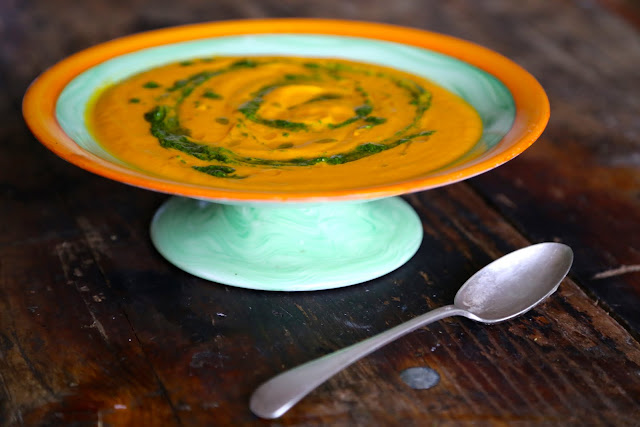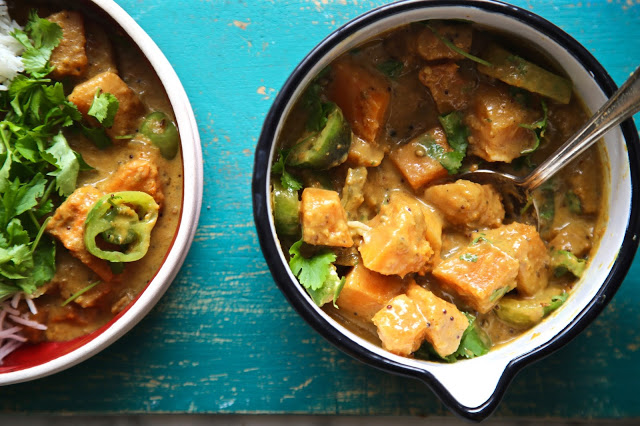We think of pumpkins as an autumnal North American food, although I was disappointed to discover that they usually buy canned when baking pumpkin pie. There is a wide selection of pumpkins and squashes: from giant pin cushion style of Turban Squash, to spaghetti squash, or the dense sweet flesh of acorn squash and butternut.
Pumpkin can be found in Mexican, Japanese, Indian and Italian cuisine. Squash are a vegetable that improves with time: they can be matured over from last year, deepening in flavour, if kept in a cool dry place. Note that the enormous pumpkins that are carved into lanterns aren’t the best for eating, being watery and tasteless.
Halloween occurs as autumn turns to winter: the wet amber leaves have been swept up and the nights begin to frost. Here are a few tips and recipes to expand your pumpkin repertoire and a couple of wine suggestions.
Interesting squashes/pumpkins you should try:
- Butternut squash. I love it roasted and tossed into salads or served with couscous, a few pomegranate seeds and parsley. The ‘coquina’ variety is nicely sweet.
- Spaghetti squash. Once baked, the centre can be forked into spaghetti-like strands. You can treat it like courgetti, a gluten-free replacement for pasta and the latest trend for fashionable ‘clean’ eaters. Or add lashings of salty butter and parmesan, as I do.
- Tromboncini. Trombone-shaped Italian squash. When young, slice up and use like courgette; when older, use like squash.
- Gem squash. Wonderfully sweet: stuff and bake.
- Acorn squash. Another small squash. Can be pureed into soup or stuffed.
- Onion squash. Small, baked, mixed with cheese. This is great on toast.
- Kabocha squash. Popular in Japan. Perfect simply roasted with soy sauce, ginger, sesame seeds and served with sushi rice.
- Hokkaido. Teardrop-shaped, deep red/orange squash. Use in a tart, a soup or simply roasted.
- Delicata squash. Italian from Lombardy. Difficult to find in the UK but it’s easier to chop up than other squashes and the skin is edible so no peeling required. Roast with a little salt.
- Crown Prince. Large blue/grey skinned squash with sweet orange flesh inside.
- Harlequin. Pointy decorative squash is also good to eat.
- Turban squash. Spectacular – looks just like a Turkish hat.
Top tips for squash and pumpkins:
- Use every part of the pumpkin.
- You can save the seeds and roast them. Just brush/scrape off most of the flesh, give them a quick wash and roast with a little salt and olive or pumpkin seed oil.
- Austria grows especially large pumpkin seeds which they turn into cold-pressed dark green Styrian oil. Dip bread into it or drizzle over roast pumpkin.
- I use pumpkin seeds in bread or scattered over salads.
- The skins or shells are effective as bowls for soup or as below, for a soufflé.
- The flowers can be used for a Mexican squash flower soup.
- Squash is also a brilliant carbohydrate filler for those who are gluten free.
- For the best tasting winter squash, experiment with some of the other cultivars available.

Pumpkin Soup Recipe
Ingredients
- 3 tbsp olive oil
- 1 large brown onion, diced
- one medium pumpkin, seeded, peeled, chopped roughly, approximately a kilo of flesh
- 1.5 litres of vegetable stock
- 1/2 tsp mace
- 100 ml of single cream
- Salt and pepper to taste
Instructions
- Using a wide, tall, large saucepan, heat the oil then soften the onion. Add the pumpkin chunks, cooking until slightly golden on the edges. Then add the stock and mace. Cook for 15 minutes then use a hand blender or a table top blender to process the chunks into a soup. Add the single cream. Season to taste. Serve warm.
- To make it vegan: replace the single cream with coconut milk. You can add a finely diced red chilli to add an exotic vibe to the soup.
Notes

Pumpkin curry recipe
Ingredients
- 3 dried kashmiri chillies, soaked, deseeded.
- 50 ml ground nut or vegetable oil
- 1 tsp mustard seeds
- 1 large black cardamom
- 1 tsp cumin seeds
- 1 tsp coriander seeds
- 1 cinnamon stick
- 2 bay leaves
- A pinch of cloves, ground
- 1 Butternut squash, peeled, deseeded and cubed
- 3 tbsps tamarind paste
- 3 cloves garlic, crushed
- 3 cm fresh ginger, grated
- 3 cm fresh turmeric root, grated
- 10 green tomatoes, red or yellow can also be used but green adds a little acidity
- 1 tbsp sea salt, less if using table salt
- 250 ml coconut milk, buy a good brand without thickeners or additives
- 30 g fresh coriander leaves, or one pot
Instructions
- Soak the chillies in boiling water. In the meantime, heat up the oil a deep frying pan or saucepan.
- Add the mustard seeds and wait until they pop. Add the cumin, coriander, cinnamon, bay and cloves. Add the butternut squash to the pan, stirring on high heat then lower the heat to medium.
- Remove the chillies from the boiling water, snipping off the stems and seeds. Place them in a blender with the tamarind paste and a little water. Blend until you have a watery paste. Add this chilli tamarind paste to the pan and stir.
- Add the garlic, then grate in the ginger and turmeric. Add the green tomatoes, followed by the salt and coconut milk.
- Cook on a medium to low heat until the butternut squash is tender. Finally, add the fresh coriander leaves and serve with rice.
Notes

Spaghetti Squash Recipe
Ingredients
- 1 spaghetti squash, whole
- Salt and Pepper to taste
- Butter
- Cheese, either parmesan or cheddar.
- Jalapeno peppers, sliced.
Instructions
- Preheat the oven to 180ºC for 20 minutes.
- Place the entire squash in a baking tray and roast for one hour or until soft when poked through with a metal skewer.
- Remove from the oven and slit lengthways down the middle. Scoop out the seeds and fork over the flesh.
- Add the toppings of your choice.





This is so inspiring because it inspired me to do some research and I found that some of the best food comes from the bowels of nature, and one of those is the pumpkin.
Apart from the mouthwatering recipes kindly provided by MsMarmiteLover,
I wonder how many people know about the nutritional advantages of pumpkins?
I had no idea that pumpkins are a Good Source of Vitamin A & Carotenoids.
Having suffered for over four decades from a skin allergy,
I had no idea that pumpkin can also help cleanse to the skin thanks to the carotenoids found in it.
So I would like to thank MsMarmiteLover for giving me some much-needed inspiration from this wonderful blog.
Thanks Trevor. The British don’t do pumpkins that much in their diet which is a shame as they are so good for you.